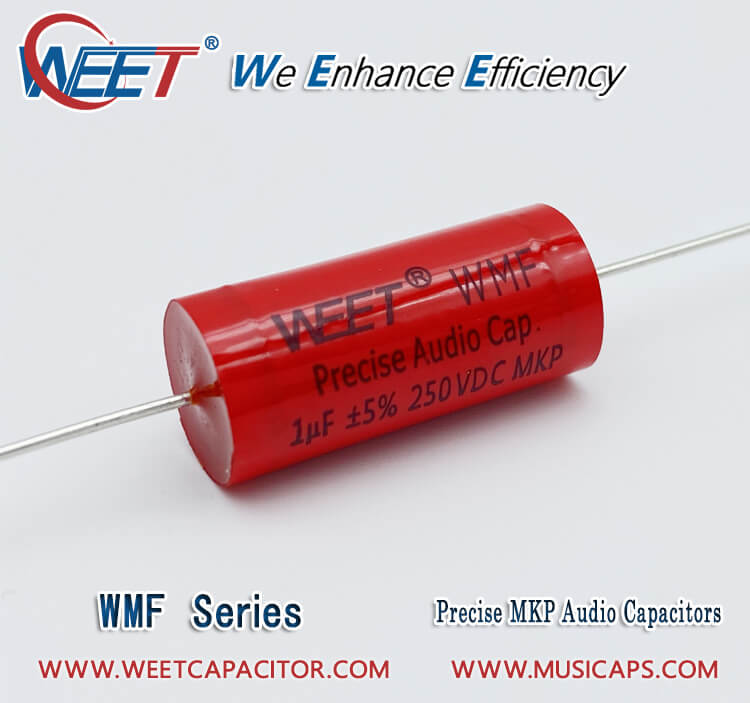WEE Technology Company Limited - WEE are Capacitors Specialist
Which sound quality is better with solid state electrolytic capacitor or audio capacitor?
There are various kinds of audio capacitors because of their different uses, different structures and different materials. Their electrical properties, structures and uses depend largely on the medium used. According to the media, they are classified into organic medium, inorganic medium, liquid oil medium and gas dielectric capacitor, etc. in terms of audio circuit, the most commonly used transistors are organic medium and inorganic dielectric electrolytic capacitor .Organic dielectric capacitance, also known as film capacitance, is mainly composed of paper dielectric (MP), metal dielectric, polyester (Mylar, also known as polyester), polystyrene (MKS), polypropylene (MKP), polycarbonate (MKC) and Polyterephthalate (MKT).
Among them, paper dielectric, polyester, polypropylene three kinds of capacitors are respectively divided into metallized medium and non metallized medium. Generally speaking, once the capacitor of metallized medium is broken down, the arc generated at the breakdown point will melt and evaporate the metal film and eliminate the short circuit. It can automatically resume normal operation and have self-healing function. The performance of this kind of capacitor is very good, which is generally used in power supply. Metallized polyester capacitor (Mylar) and metallized polypropylene capacitor (MKP) can eliminate the inductance caused by winding, and make a better performance non inductive capacitor. This kind of capacitor should choose the nominal capacitance on the capacitor, and the winding process is special, so the non inductive capacitor can be made. The inorganic capacitors are mainly mica, ceramic dielectric, single stone and glass glaze.
Electrolytic capacitor is represented by aluminum electrolytic capacitor, which has the characteristics of small volume and large capacity. It can achieve dozens of micro methods to 20000 or 30000 micro methods, but its impedance frequency characteristics are poor, temperature characteristics are not good, low insulation resistance, large leakage current, long time not used will deteriorate and fail. Because the conductivity of electrolyte is not very good, the resistance is large, the loss is also large, the distributed capacitance and error are not very small, so the performance of electrolytic capacitor is far inferior to that of thin film capacitor. It is only suitable for power filter and power decoupling, not suitable for audio frequency coupling circuit.

WEE Technology Company Limited - WEE are Capacitors Specialist
What is the best for your speaker and crossover applications MKP or MKT capacitors?
1. MKP: MKP has high withstand voltage starting point, small lead out loss, small internal temperature rise, negative capacity temperature coefficient, excellent flame retardant performance. It is used in high voltage and high frequency pulse circuit, S-correction and reverse stroke waveform in TV and display, electronic rectifying absorption and SCR rectifying circuit in lighting circuit.
2. MKT: non polarity, high insulation impedance, excellent frequency characteristics (wide frequency response), and small dielectric loss. Thin film capacitors are widely used in analog circuits. Especially in the part of signal cross connection, it is necessary to use capacitors with good frequency characteristics and very low dielectric loss, so as to ensure that the signal will not have too much distortion during transmission.
It can be seen from the above that the frequency characteristics of MKP should be better than that of MKT. All film capacitors are enough for audio coupling, and high-frequency electrolysis of industrial products is not bad, but capacitors are the components that have the greatest impact on timbre. Replacing a pair of coupling capacitors is enough to change the sound trend of the whole machine. MKT is called polyester capacitor in China, Because of its low price and good high-frequency characteristics, many domestic machines are used, and the timbre is bright, hard and dry. Compared with MKT, the timbre of MKP is soft, transparent and delicate. Its listening feeling is similar to that of some audio special electrolysis. BP audio electrolysis is more used in coupling, and MKP is only used in small capacity occasions.
Conclusion: WEET WMF MKP Precise Audio Capacitor 6.8uF +/-5% 250VDC is the bet alternative for your speaker and crossover applications.
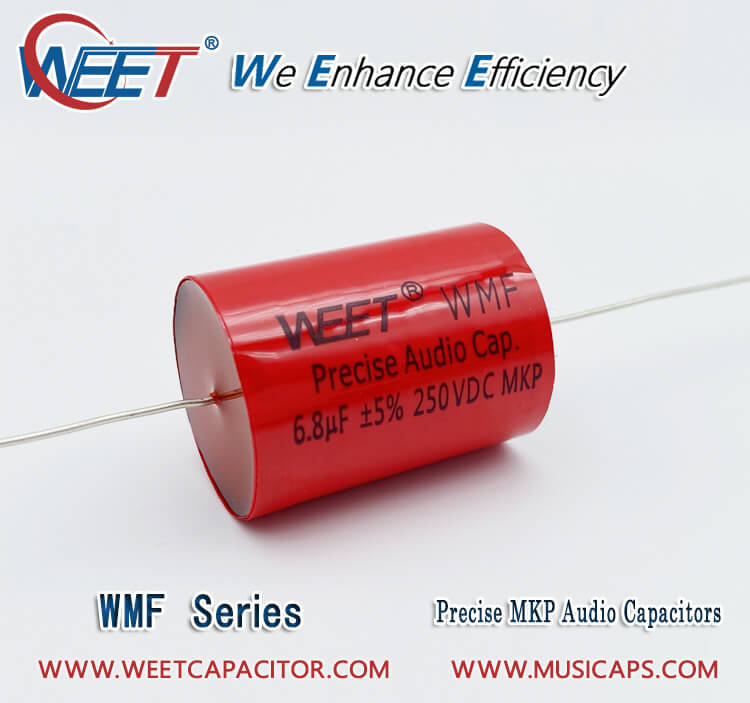
WEE Technology Company Limited - WEE are Capacitors Specialist
Is the MET capacitor on audio frequency divider the same as MKP capacitor ?
The answer is No, the two capacitors use different media dielectric
MET: Metallized polyester film axial capacitor
MKP: Metallized polypropylene film axial capacitor
MKP is usually used for treble, and MKP is better than MET, especially for high frequency signal (treble).
MET is not so good, but in order to reduce the cost, it will be used, and it has no obvious effect on bass applications.
WEET WMF Precise Audio Capacitors the largest capacitance is up to 200uF, which is very special and difficult to produce.But WEET can do it .
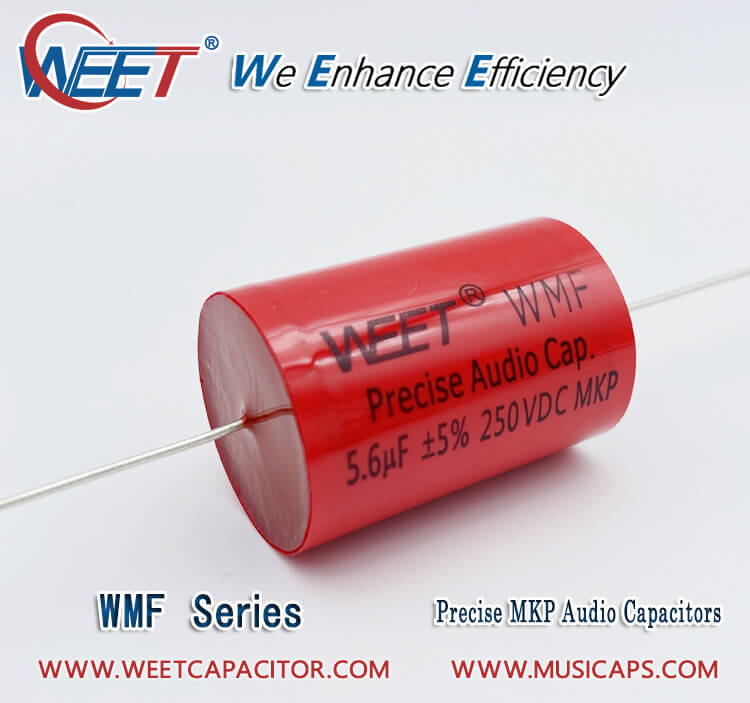
WEE Technology Company Limited - WEE are Capacitors Specialist
Can capacitors with different capacities and the same voltage be used in parallel
Can Combine capacitors in parallel?
Calculating the total capacitance of two or more capacitors in parallel is simple: Just add up the individual capacitor values to get the total capacitance.
This rule makes sense if you think about it for a moment. When you connect capacitors in parallel, you’re essentially connecting the plates of the individual capacitors. So connecting two identical capacitors in parallel essentially doubles the size of the plates, which effectively doubles the capacitance.
Remember: Whenever you see two or more capacitors in parallel in a circuit, you can substitute a single capacitor whose value is the sum of the individual capacitors. Similarly, any time you see a single capacitor in a circuit, you can substitute two or more capacitors in parallel as long as their values add up to the original value.
Tips: The total capacitance of capacitors in parallel is always greater than the capacitance of any of the individual capacitors. That’s because each capacitor adds its own capacitance to the total.
Summary: We do not suggest to combine capacitors, as the more capacitors you combine, the bigger total capacitance you will get. Usually you have to choose the single right capacitance capacitor for your application.
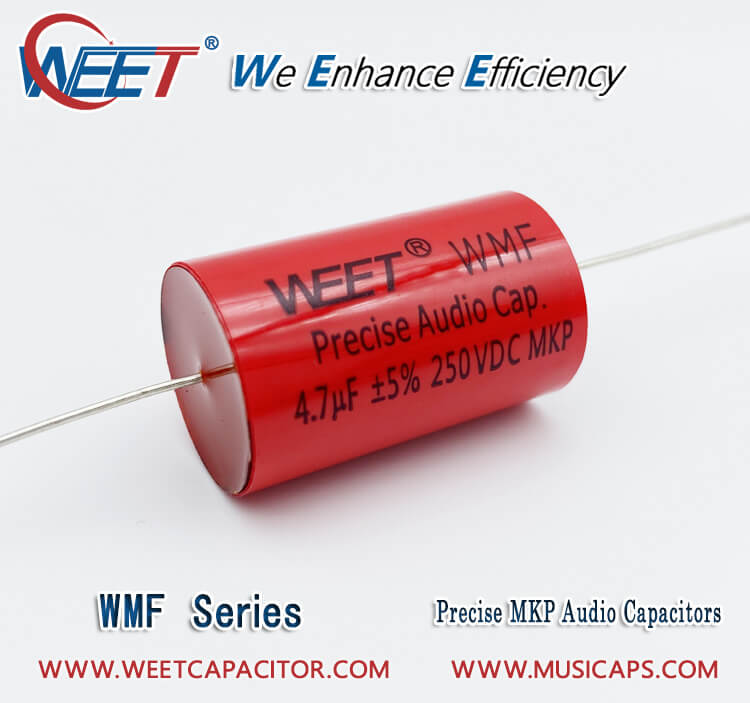
WEE Technology Company Limited - WEE are Capacitors Specialist
400V 3.3uF frequency divider audio MKP Non polarized frequency dividing capacitor, also called as new audiophiler MKP red film kondensotor 400V 3.3uF film capacitor, axial lead.
Can WEET WMF Precise Audio Cap. 250V 3.3uF capacitor be replaced by 400V 3.3uF Capacitor?
Yes, the principle is that the withstand voltage must be the same as or higher than your original one, and the capacity is the same, but don't be too big. If it is too large, it will be wasted. Because the higher the withstand voltage is, the larger the capacity is, the more expensive the capacitor will be!
If the 250V 3.3uF capacitor is broken, whether it can be replaced by 400V 3.3uF depends on the starting function of the capacitor in the circuit.
The general power supply line is OK, but it can't be used as the motor starting capacitor.
For more technique information, you can email to info@weetcapacitor.com, we are ready to provide the best solution to your audio application circuit, thank you.
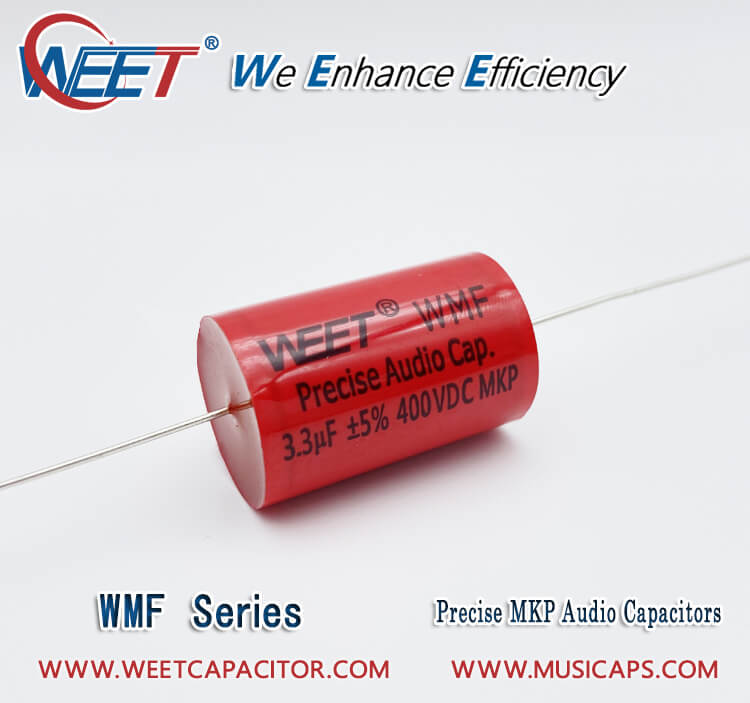
WEE Technology Company Limited - WEE are Capacitors Specialist
Film capacitor is also called plastic film capacitor. It takes plastic film as dielectric.
Structure of Plastic film capacitors:
The internal structure of the film capacitor is mainly composed of metal foil (or foil obtained by metallization on plastic) as electrode plate and plastic as dielectric. It is produced by winding or laminating process. Different arrangements of foil and film lead to a variety of structure.
Classification of Plastic film capacitors:
Thin film capacitor is composed of dielectric, electrode, electrode transition, lead out, package, seal and mark.
According to the media classification: polyester film, polypropylene film.
According to the structure classification: winding type, laminated type, inside string type.
According to the electrode classification: metal foil, metallization (aluminum metallization, aluminum zinc metallization), film foil composite structure.
According to the electrode lead out way classification: radial, axial.
According to the packaging mode: box type, immersion type, bare package.
Plastic film capacitors Summary
Thin film capacitor is the closest "ideal capacitor", but it has the advantages of high voltage, high power, high frequency, high stability, high reliability and long service life. It is used in automobile, locomotive, wind power, photovoltaic and other equipment to replace electrolysis.
WEET 3.3uF +/-5% 250VDC MKP Precise Audio Capacitor is the best choice for audio crossover application and speaker system.
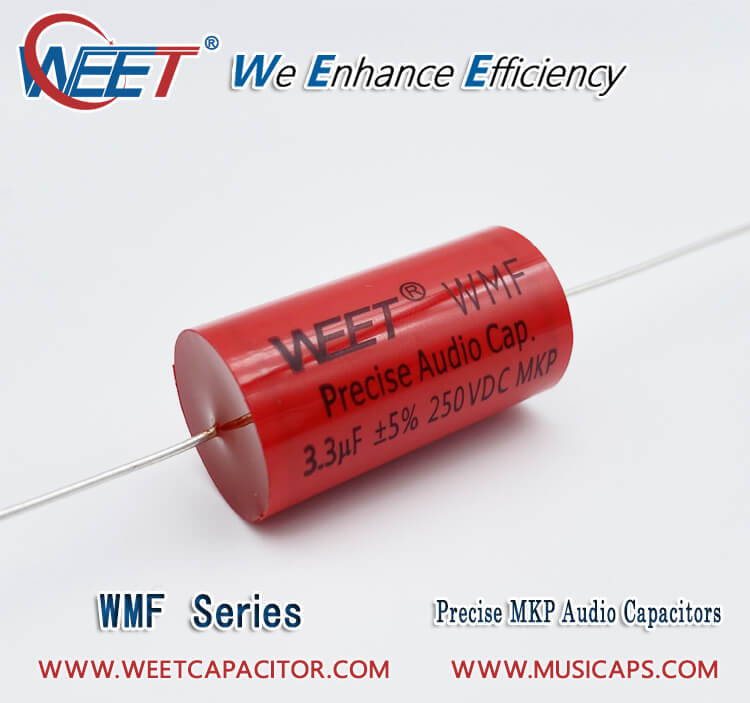
WEE Technology Company Limited - WEE are Capacitors Specialist
If you know how to select the suitable crossover capacitor for the audio applications and your speaker system will achieve its maximum performance.
WEE Technology supplies superior Film and Foil Capacitors, Metalized Polypropylene Capacitors, and Non-Polarized Electrolytic Capacitors that are suitable for the most discriminating audio applications.
Film and Foil Crossover Capacitors: https://www.musicaps.com/WEET-Foil-and-Film-Audio-Capacitors.html
Metalized Polypropylene Crossover Capacitors: https://www.musicaps.com/WEET-Metallized-Polypropylene-Film-Capacitors.html
Non-Polarized Electrolytic Capacitors:https://www.musicaps.com/WEET-Aluminum-Electrolytic-Audio-Capacitors.html
Differences in audio capacitors
Capacitors are the focus of this technical bulletin. There are four basic types of capacitors: electrolytic, ceramic, metallized film and film and foil. (Aluminum Foil and Copper Foil)
Choosing capacitors for crossover networks
The types of capacitors that are commonly used for audio applications include ceramic, electrolytic and film capacitors. These types of capacitors differ in design, construction and performance characteristics. It is usually important to consider the unique needs of your audio application when selecting a capacitor.
The quality of sound produced by an audio circuit is greatly dependent on the audio frequency response of capacitors used. In general, ceramic capacitors have poor audio frequency response. Moreover, the low insulation resistance and relatively high equivalent series resistance of ceramic capacitors make them unsuitable for crossover networks.
Film capacitors are widely used in audio circuits for a wide range of applications. For the optimum performance of a crossover network, film capacitors with low dielectric absorption and equivalent series resistance are commonly used. The characteristics of film capacitors make them the number one choice for audio applications. It is common for circuit designers to use a combination of different types of capacitors.
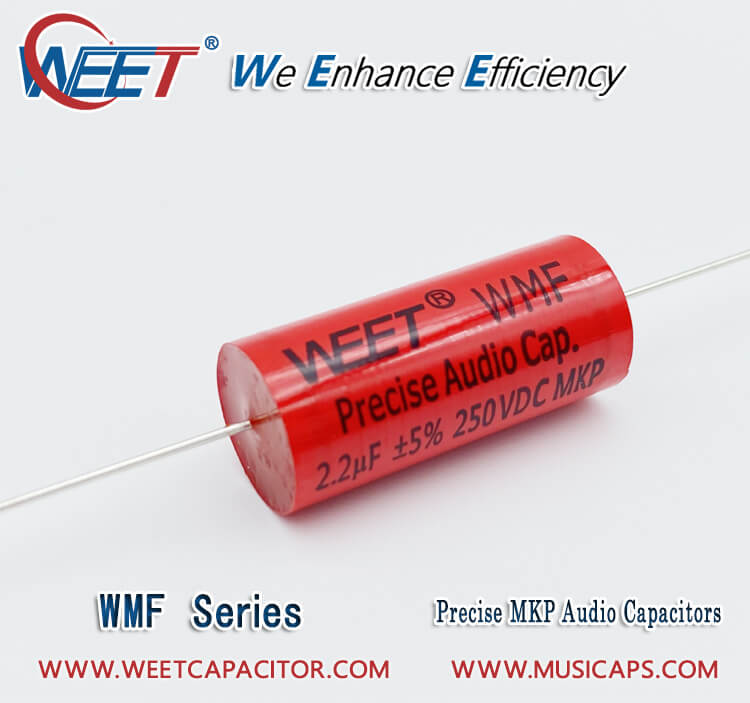
WEE Technology Company Limited - WEE are Capacitors Specialist
How to choose audio frequency capacitor? These five parameters let you identify the capacitance
Basic information Capacitance, voltage and Temperature
*Electrostatic capacity, expressed in UF. The common ones are 0.1uF, 0.22uf, 0.47uf, 1uF, 6.8uf and so on.
*The working voltage (WV) should be the nominal safe value, that is to say, the nominal voltage should not be exceeded in the application circuit.
*Temperature, most of the common 85 degrees, 105 degrees. Under high temperature conditions, 105 ℃ nominal is preferred. In general, the optimization of high temperature coefficient is helpful to improve the performance of other parameters.
Dispersion factor (DF)
Sometimes the DF value is also expressed by the loss angle tan. Whether the DF value is high or low is related to temperature, capacity, voltage and frequency; when the capacity is the same, the higher the withstand voltage, the lower the DF value. The higher the frequency, the higher the DF value and the higher the temperature.
Equivalent series resistance ESR
The level of ESR is related to the capacity, voltage, frequency and temperature of capacitor. The lower the ESR requirement, the better. When the rated voltage is fixed, the larger the capacity, the lower the ESR. When the capacity is fixed, the ESR can be reduced by selecting high rated voltage. ESR is high at low frequency, low at high frequency, and increases at high temperature.
Leakage current
The smaller the leakage current, the better! The higher the capacitor capacity is, the greater the leakage current will be; reducing the working voltage can reduce the leakage current. Conversely, choosing a higher withstand voltage type will also help to reduce leakage current. Combined with the above two parameters, it is a simple and feasible method to select high voltage withstand varieties under the same conditions; it can reduce internal resistance, reduce leakage current, reduce loss angle and increase life.
Ripple current Irac
Ripple current is a very important parameter for the filter circuit of stone machine. The higher the ripple current Irac is, the better. The higher the frequency, the larger the Irac, and the lower the frequency, the smaller the Irac. According to the traditional view, we need to be able to have a high ripple current at low frequency, in order to obtain good high current discharge characteristics, make the low frequency more solid and full of elasticity, as well as good control and driving characteristics. In fact, at high frequencies, a high ripple current is also very helpful to the positive aspect of the timbre, which can make the high frequency have better extension and reduce the roughness.
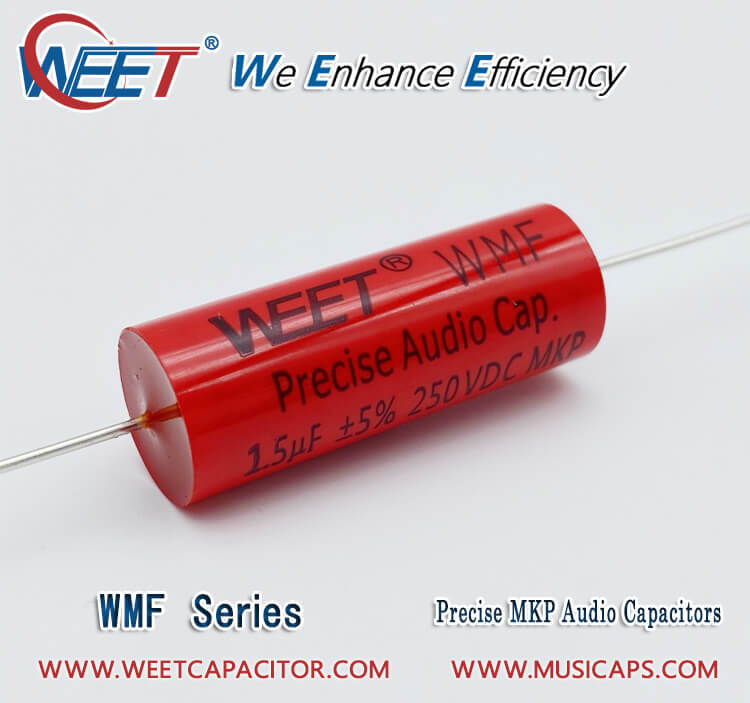
WEE Technology Company Limited - WEE are Capacitors Specialist
The best capacitor types for audio circuits are polystyrene and polypropylene.
Polystyrene is the first choice, but are only available in values up to .001 uF.
Above that value, polypropylene is the type of choice, WEET can produce 0.1uF to 100uF capacitance with 250V,400V and 630V voltage.
With nearly the same qualities of dissipation factor (DF) and dielectric absorption (DA) as polystyrene (these are the two capacitor “qualities” that most affect audio applications).
The WEET WMF Precise Audio Capacitors DF is less than 0.05% in general, due to the size of the capacitors, the bigger ones will get a little higher DF.
WMF is the top line of MKP polypropylene film capacitors for crossover, bypass and speakers. Free samples are on request, thank you.

WEE Technology Company Limited - WEE are Capacitors Specialist
WEET would like to recommend the best MKP capacitors for Tweeter to all the audiophiles.
MKP Audiophiler audio grade non-polarized crossover capacitors made in China. These are the highest quality crossover capacitors available today.
Rated at 250V, 400V and 630V for plenty of headroom in high-wattage applications.
Top MKP Audiophiler capacitors values include 1uF, 2.2uF, 3.3uF, 4.7uF, 6.8uF, and 10uF.
WEET WMF Audio capacitors cross reference to Audyn Cap MKP Metalized Polypropylene
When replacing a capacitor in an existing printed circuit crossover board, order the same capacitance value (in uF - microfarads) as the original.
Our Audiophiler capacitors are rated at a maximum of 630 volts, which offers significant margin over typical voltages found in audio speaker circuits.
